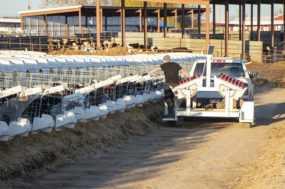With milk market availability no longer a certainty, many producers are wondering how they can make their operations attractive for a direct supply contract. For the first 20 years of my career, I worked for consumer packaged goods (CPG) companies.
I’m now helping facilitate direct supply relationships for dairy producers. Based on my experiences, I can offer some insights into how these companies purchase milk and what details can make the difference in being selected as a preferred milk supplier.
While milk markets are extremely favorable for CPGs right now, there will still be some interested in partnering with the right suppliers for the mutual benefit of long-term predictability and pricing sustainability. When the milk market swings back in your favor, you must be willing to sacrifice some of that margin for them. If this is of interest to you, then read on.
Know your value
To interest a company in purchasing milk directly from your dairy farm, you must identify what would make you a valuable supplier. Since value is ultimately determined by the buyer, think in terms of their perspective. Most CPGs purchase milk through their procurement division and, more often than not, they treat it like a commodity buy.
Procurement teams typically review potential suppliers in a formal process, evaluating them in several categories such as product quality, price, customer service, delivery timelines and flexibility.
Today, more companies are also looking at additional elements driven by consumer demands, including environmental sustainability and business transparency. Overall, they are looking for a story to tell that supports their brand narrative, so your story must entice them. Let’s review some of these areas in terms of a dairy farm supplier.
-
Product quality and price – How does the component profile and quality of your milk compare to what is currently available in the market? If you have above-average components and significantly lower somatic cell count, then you might be able to offer a better-quality product at the same market price.
If you can adjust your component profile to align with the customer’s processing needs (cheese, ice cream, etc.), then that could help drive efficiencies for them and give you an edge.
-
Delivery timelines and customer service – If you begin selling milk directly, the shipping logistics will likely become your responsibility, as will aligning to the customer’s processing timetable – not necessarily your milking schedule. Obviously the ability to consistently deliver milk on time will be of importance, but just as important will be the distance the milk must travel from your dairy to their facility.
Shipping distance contributes significantly to a product’s environmental impact and sustainability, so some companies limit the distance of suppliers to within a specific radius. If you can find a customer in close proximity and reduce the distance milk has to travel to their processing facility, it could be a key selling point.
-
Transparency – Consumers want to know where their food comes from and that it was produced in a way that resonates with their values. Whether it’s a quality award from your co-op, or animal welfare and environmental certifications, these can help increase your overall value package and display a willingness to be transparent.
If you don’t currently have any, start by reviewing the National Milk Producers Federation’s Farmers Assuring Responsible Management program (nationaldairyfarm.com) to learn what these certifications will require.
Many companies post their supplier requirements online. If you have a specific customer in mind, do some research to learn what they value most and see how well you align – or could align – with those values.
Know your vulnerabilities
If a CPG is going to work directly with your dairy farm to supply their milk, you need to be aware of the risk they are taking on. Anything negative that happens at the farm level could be linked directly to their product brands. A scandalous animal welfare video, a farm accident with a tragic end or a manure spill could all reflect back on the product brand and leave a bad impression in the consumer’s mind.
This is why transparency is crucial. However, before you pull back the curtain on your dairy, identify your vulnerabilities. Start by taking a hard look at your dairy through the lens of the customer. By spotting potential pitfalls early, you can work to correct or minimize them so they don’t disrupt a potential direct supply deal. Let’s break this down into farm optics and farm records.
-
Farm optics – Farm optics are what people will experience when they step onto your farm for an up-close and personal look. Don’t get comfortable thinking your cows or landscape look great; it goes way beyond that. What are the conditions of your breakroom or office, and how might they be perceived by someone who is accustomed to a corporate setting?
Would you be comfortable letting a female milk purchaser use the barn restroom? Where do you put the animals the rendering truck picks up? Are they easily visible to anyone driving by, or is there a visual barrier? If you provide employee housing, what are the living conditions, and how do they compare to other houses on-site? I recommend giving a tour to a friend from town and asking them to point out anything that appears in a negative light. You might be surprised by what grabs their attention and the questions they ask.
-
Farm records – Opening up your farm records will go well beyond your herd management software and tax returns. Be prepared to openly share everything from drug residue warnings to employee turnover rates. What story do these records tell for the last three months and the last three years? If there were high incidences of disease or long periods of poor-quality milk, be ready to explain why and how it was corrected.
Finally, be aware of how this story compares to your farm optics. If optics give the impression of the Taj Mahal of dairy farms but the books read on the verge of bankruptcy – or vice versa – what does that tell the CPG? If there were times you didn’t break even, why? If you are looking to secure a direct supply contract for an extended period, the buyer needs to trust you know how to manage your business in a responsible and sustainable way.
Know the vernacular
Communication quickly becomes noise when the person across the table doesn’t understand you. Working with a CPG is much like dealing with a foreign company. Your businesses and industry terminology are worlds apart; there’s a knowledge gap that must be bridged. Working with a trusted third party who understands both business worlds, and the unique terminology of each industry, is like having a trusted translator at the table.
You wouldn’t do business with a company in Japan without a translator, even if you took a Rosetta Stone course. The translator would still be needed to help navigate language and cultural barriers to ensure both parties fully comprehended the terms of a deal.
Consulting early with the right third party, particularly one who’s been down this path before, can be extremely beneficial. From helping you define your value proposition and minimize your vulnerabilities to helping identify the best potential customer, they can help you properly prepare before approaching a milk buyer with a direct supply proposal.
If you do the right homework, and are prepared with the right support, a direct supply agreement might be a win-win for all. ![]()

-
Ryan Toney
- Cargill Dairy Enterprise Group
- Email Ryan Toney







